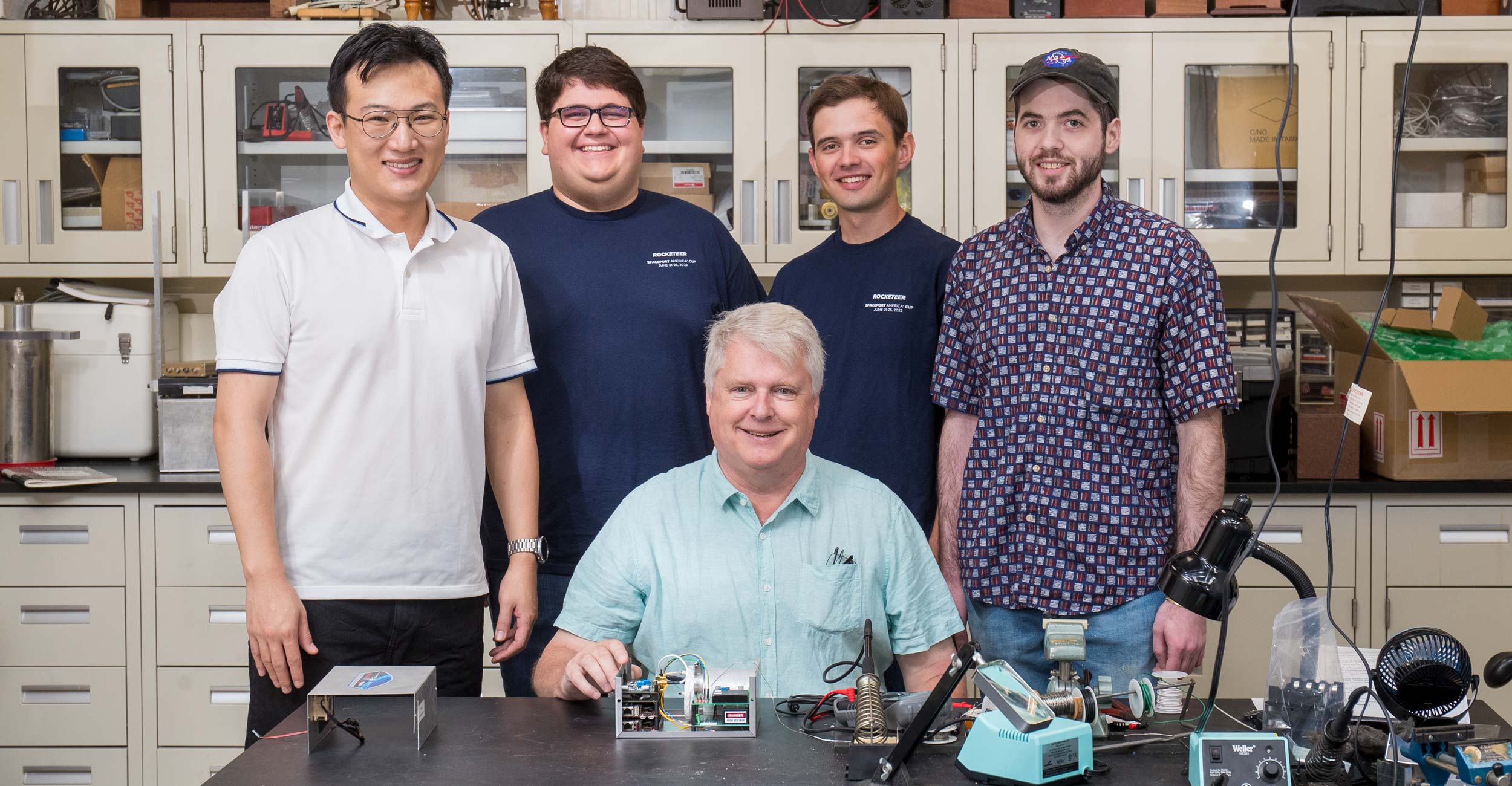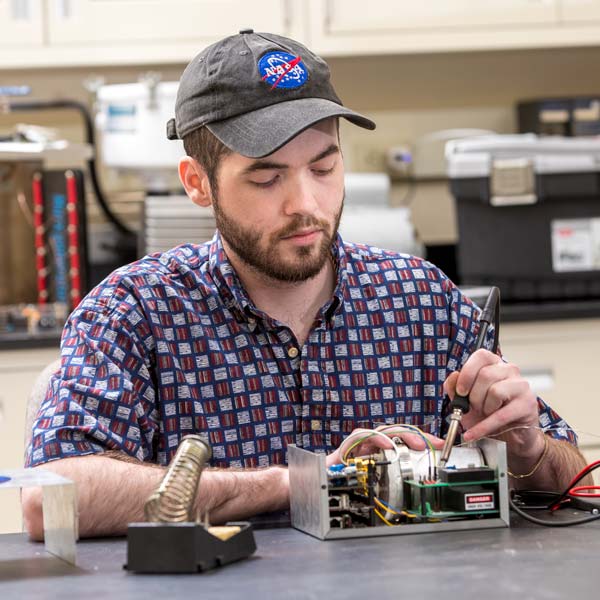
OSU physics professor and students develop technology to test radiation in space
Monday, October 17, 2022
Media Contact: Elizabeth Gosney | CAS Marketing and Communications Manager | 405-744-7497 | egosney@okstate.edu
Around 100 kilometers above the Earth, outer space starts. And right on that edge — called the Kármán line — is where a growing interest in space tourism and a need for new research is beginning.
On that edge is also where a team of researchers at Oklahoma State University is focusing to understand how radiation works in the atmosphere and its impact on technology and people.
Dr. Eric Benton, a radiation physicist at OSU’s College of Arts and Sciences, is leading the research with his team at OSU and has a radiation detector set to fly on a Blue Origin rocket in 2023.
The flight will be suborbital — flying up between 100 to 120 kilometers (around 60-75 miles), Benton said. It’s a very short flight, only about 11 minutes, he added.
But while the flights are short, the radiation is considerably more intense than what a person will get on the ground, or while flying in a commercial jetliner. The duration of the flight means there isn’t much danger, but there is still a need to monitor radiation, Benton said.
“It is prudent and ethical to pay attention to it and to measure it,” he said. “If something very strange happens physiologically with somebody, then you can probably rule out radiation as being the culprit because you would have independent measurements saying that the radiation level was really low or well within expected limits.”
Outside of health and safety, radiation also plays a key role in the ever-advancing technology age.
“A lot of electronics are quite sensitive to radiation,” Benton said. “And they are getting more sensitive because they’re shrinking the size of these electronics down. So they’ve got to pay attention to that.”
This detector was developed as part of a program called the AIRE Institute, which Benton started at OSU with a couple of colleagues.
“AIRE stands for atmospheric ionizing radiation environment,” he said. “And so, as the name says, we’re really interested in the radiation environment that’s found in the atmosphere, especially at higher altitudes.”
The institute is something that’s evolved out of work that all got started because of NASA EPSCoR, Benton said.
“NASA EPSCoR in Oklahoma and nationwide, but in Oklahoma especially for me, has been really generous in supporting our work,” Benton said. “In 2008, when we got our first
NASA EPSCoR grant for this radiation detector technology — that really started this.”
Benton had been doing space research before using other kinds of detectors called passive detectors that act like film. But as technology improved, there was a demand to be able to see the time radiation occurred as well, Benton said.
“That meant abandoning these passive radiation detectors and going for what is called active radiation detectors: electronic devices that store the data on a computer,” he said. “So it was really clear, this is where I had to go.”
It turns out that one of the people who developed this active technology had retired to Stillwater and was working with a researcher named Stephen McKeever, who was in the physics department at OSU and later served as vice president of research from 2003-2013.
“And I realized that I need to learn how to do this. I need to learn this new technology, this is where my future is,” Benton said. “So, we started from scratch. I mean, similar detectors had been flown before, but they were very expensive. And it was pretty much proprietary technology. We had to reinvent the whole thing from scratch for ourselves. And the real major emphasis we put on it was to make it a lot cheaper.”
Since then, most of what the team has worked on in the past has been space oriented, which would be at an altitude of around 400 kilometers. But now they are looking more toward the sky, and not past it.
“With Blue Origin and Virgin Galactic, they’re starting this whole idea of space tourism,” Benton said. “And we hope to be the radiation dosimetry providers for space tourism, and this is sort of our first shot at that.”
From a scientific point of view, very few measurements have ever been taken on these suborbital flights, Benton said.
“There’s lots of data from space and from aboard the space station, and before that from space shuttles and spacecraft like that, but up at these higher altitudes in the atmosphere, there’s practically none,” he said. “We’re very interested in filling in that gap in our knowledge.”
The detector itself consists of several parts, but the main piece is called a tissue equivalent proportional counter.
“This is a spherical detector that is filled with low-pressure gas. And the tricky thing is that it’s a rather large sphere, maybe about two inches in diameter, but the gas is under very low pressure,” Benton said. “And the walls of the chamber are made of plastic, which is essentially the same as tissue — it’s carbon, oxygen and hydrogen — so the density is very similar to human tissue.”
This means the response of the detector to radiation, which is monitored on a computer, is very similar to that of what human tissue would be to that same radiation, which simplifies how the radiation is going to affect passengers and pilots quite a bit, Benton said.
And everything fits into a small container a little smaller than the size of a shoe box.
For the Blue Origin flight, the team has been assigned one of 36 lockers aboard the ship where they will not only mount their detector, but also plan to include more detectors from other organizations to compare data with.
The other detectors Benton and his team intend to include will be from a company called HERADO, based in Athens, Greece; the Solar and Terrestrial Physics Institute of Bulgaria; and the Nuclear Physics Institute of the Czech Academy of Sciences in the Czech Republic.
“This all ties into something that’s called space weather,” Benton said. “There has been a growing appreciation amongst industry that things that are happening on the sun can have really adverse effects on our technology, or on health.”
The team is hoping to fill in this niche in the study of space weather that is just now getting new attention, Benton said.
Outside of their suborbital tests, Benton’s team is also preparing a detector to fly on a SpaceX rocket to be deployed on the International Space Station in 2023 and is working on detectors for lower-level balloon flights with OSU’s Unmanned Systems Research Institute.


Photos By: Phil Shockley | OSU Photographer
Story By: Harrison Hill | harrison.c.hill@okstate.edu
